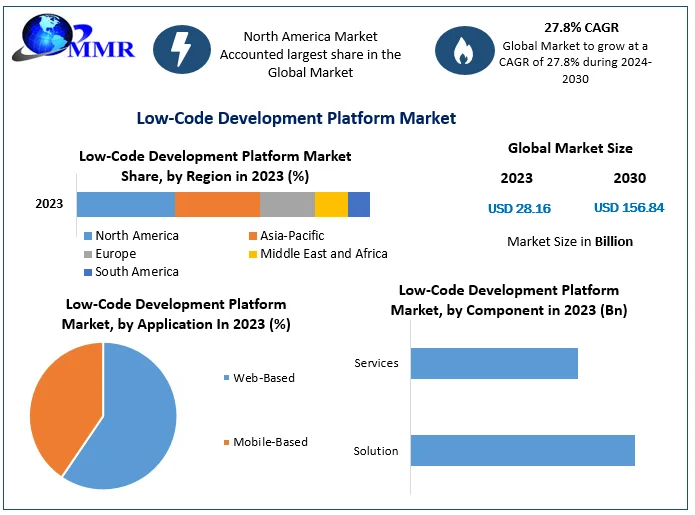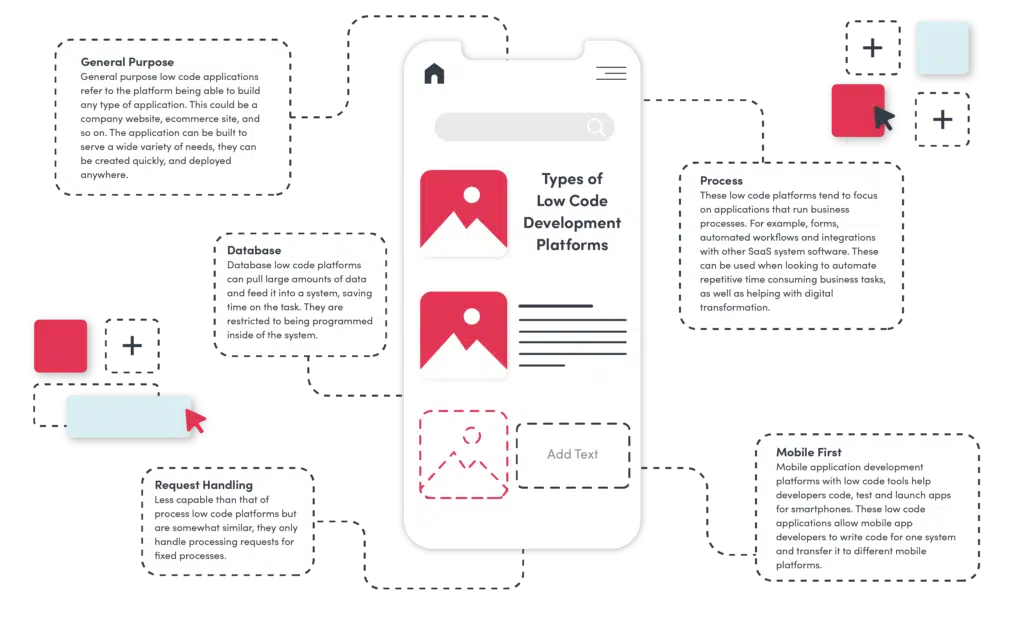Handy Suggestions On Deciding On Low-code platforms for application development
Wiki Article
App Development Using Low-Code Is More Efficient.
Visual Development Environment (VDE):
Drag-and-Drop Interfaces: Low-code platforms provide visual tools for designing applications. Drag-and-drop tools let developers quickly create applications without writing long lines of code.
Pre-built Templates and Components A number of low-code platforms include templates and components that are pre-built, which enable developers to swiftly prototype and build applications without having to start from the beginning.
Reduced Coding Requirements:
Automated Coding Generation Low-code platforms generate the code automatically in accordance with the visual model created by developers. This eliminates the requirement to code manually and speeds up the development process.
Reusable components: Developers are able to use reusable component across a variety of projects, which can reduce the amount of time they're spending writing and testing code.
Collaboration is made easier:
Low-code platforms come with a variety of tools that facilitate seamless collaboration between development teams. They include version control, testing and deployment.
Citizen Development: People who are not developers and business users can use simple interfaces to help in the development of applications which reduces bottlenecks caused due to a shortage of professional developers.
Rapid Iteration & Prototyping
Rapid Prototyping: Designers can quickly build prototypes that can be used to test ideas and get feedback, which results in faster the cycle of iterations.
Easy modifications. The visual nature that low-code development gives makes it easy to modify and update applications. This accelerates the process of enhancing and improving applications based on feedback from users.
Pre-built Integrations:
API Integrations Low-code platforms have prebuilt connectors that are compatible with APIs or services that are popular. They reduce the time it takes to connect external applications.
Data Integration: The integrated tools make it easier for connecting to databases and other sources, accelerating the process of development.
The deployment of scaling:
A lot of low-code platforms offer an option to deploy applications in one click that reduces the amount of time and effort needed to deploy applications.
Cloud-based solutions: Cloud low-code platforms are capable of handling the management of infrastructure and scaling. Developers are able to concentrate on functions and application logic instead of deployment logistics.
Low-code development of applications is a more efficient method to create apps. It streamlines and automates various aspects of the procedure. This makes it easier to speed up delivery and adaptation to the changing needs. Have a look at the most popular Low-code Platform for application development for more examples including push notifications android, rad development, app dev platform, rapid action development, push notifications, develop mobile application, app modernisation, mobile app development platforms, multiplatform mobile app development, azure sql databases and more.

Advantages Of Low-Code Application Development With Respect To Governance And Security
Low-code development offers many benefits in terms of security and governance. They are essential for ensuring applications are safe, secure and properly managed throughout their lifecycle. These are the main advantages.
Unified Management Console: Low-code platforms typically provide a centralized management console, where administrators are able to supervise and manage all applications to ensure a uniform governance throughout the entire organization.
Role-Based Access Control RBAC (RBAC). These systems typically include robust access control based on roles, allowing administrators the ability to define and apply their own access rules. This permits only authorized users to modify or access certain parts of a program.
Compliance and Regulatory Conformity:
Many low-code platforms include built-in compliance functions. They are built in line with the industry standards as well as regulations and laws (e.g. HIPAA, GDPR). They provide tools and frameworks to help ensure that applications are compliant with these requirements.
Audit Trails and Logging: Complete logging, audit trails and logs are usually integrated into organizations that allow them to keep track of changes and track access. They can also verify compliance with external and internal laws.
Increased Security Measures
Data Encryption. Low-code platforms usually provide encrypted data built-in, both in transit and during rest. This helps protect sensitive information.
Security Certifications: Many providers of low-code software have security certifications such as ISO 27001 or SOC 2, which demonstrate that they follow strict standards. These certifications provide additional assurances to users.
Automated Security Updates
Regular updates and patches Low-code platforms usually are capable of handling security updates and patches regularly. This ensures that applications remain safe from the latest security threats, and without developers having to manually intervene.
Security Monitoring: Continuous monitoring of security tools are often used, which provide real-time alerts and insights into security risks that might be present.
Data Governance
Data Access Policies: These tools permit organisations to define, enforce and monitor data policies. This ensures that information is only available to authorized users and that they are used in the correct manner.
Data Masking, Anonymization, and Anonymization Tools: These programs can help safeguard sensitive personal data and are particularly useful in testing environments.
Consistent Application Management:
Pipelines for development and delivery: Low-code platforms often have integrated development pipelines and delivery pipelines that include security tests. Security is assured throughout the entire lifecycle.
Version Control. The integrated version management system helps to track and reverse any changes that are made to the program, ensuring that the integrity of it is maintained.
User Authentication, Authorization and Authorization
Single Sign On (SSO): Supporting single sign-on and other advanced authentication techniques simplify management of users while increasing security.
Multi-Factor Authentication – Many platforms have integrated functionality to verify multi-factor identities, providing an additional layer of security.
Policy Enforcement and Compliance monitoring:
Policy Templates: Platforms that are low-code typically come with pre-defined policy templates that help organizations quickly establish governance and security policies.
Tools for Monitoring Compliance They provide continuous monitoring and reporting about compliance levels, which makes it easier to recognize and resolve any issues that could arise.
Integration with Existing Security Infrastructure:
Seamless Integration: Low-code platforms are designed to work seamlessly with existing security infrastructure and tools, such as identity management tools and SIEMs (Security Information and Event Management Solutions), and firewalls.
API Security: Integrated API security guarantees that integrations with other systems are secure. Keep data safe and ensure the consistency of your application.
Training and best Practices
Best practices guides: A lot of platforms include guidelines and recommended methods for developing secure applications. They help non-developers comply with security standards.
Some low-code providers provide security training that helps users learn how to develop and maintain secure applications.
Overall the governance and security benefits of low-code development make sure that applications are created and maintained in a safe as well as compliant method. These platforms offer all the tools and frameworks required to safeguard sensitive data and enforce policies, while ensuring regulatory compliance. See the best Legacy application modernization with Low-code for blog info including ms azure sql, cross platform mobile app development, develop web app, rad development, cloud software applications, rad development, database in azure, lowcode no code, cross platform mobile app development, lowcode no code and more.

Advantages Of Low-Code Application Development In Terms Of Support From Vendors And Community
Low-code development platforms for applications have significant advantages in terms of the support provided by vendors and communities. These are essential for an effective implementation, ongoing maintenance and constant enhancement of applications. Here are a few of the main benefits: Vendor support
Comprehensive Technical Support:
Support Teams: Many platforms that make use of low-code offer dedicated support teams to help with technical issues or troubleshooting, as well as guidance.
Some vendors provide support 24 hours a day. This is particularly beneficial to global businesses with various time zones.
Training and Onboarding
Training programs that are structured: Vendors offer structured courses like webinars or certification courses. This helps users to quickly get to grips with the platform.
Personalized Onboarding : A lot of vendors offer customized onboarding services that assist new customers install the platform and modify it according to their specific requirements.
Regular updates and enhancements
Continuous Improvement : Low-code platform manufacturers often release regular updates that add new functionality as well as performance improvements and security patches. These updates ensure that their platform is up to date and secure.
Feedback Integration Vendors incorporate user feedback into the development process and ensure that the platform changes to adapt to changing requirements.
Comprehensive Documentation:
User documentation in detail Users will find solutions to their questions by referring to an organized and detailed manual that covers all the aspects of the program beginning with its fundamental functionality to more advanced modifications.
API References: Detailed API documentation assists developers in integrating the low-code platform into other systems and customize their applications effectively.
Consulting and Professional Services
Expert Consultation. Vendors offer a wide range of consulting services, including architectural design, strategic planning and complex platform implementations. These services will ensure that users get the most out of their platform.
Custom Development Services Some vendors offer customized development services for certain functions or integrations that aren't available out of the box.
Community Support for the Community
Active User Groups:
Forums and discussion boards: Many low code platforms have active online communities that allow users to ask questions, exchange solutions and work together on best practices.
Meetups and User Groups: Local or virtual user groups and meetings offer opportunities to learn, network and sharing knowledge.
Knowledge Sharing and Collaboration
Community-Contributed Resources: Users often share templates, modules, and extensions that they have developed, which can be reused or adapted by others, accelerating development and innovation.
Crowdsourced Problem Solving: The collective knowledge and experiences of the community can be a great source for identifying issues and finding innovative solutions to complex problems.
Learning and development:
Community-Led Learning: Many communities host workshops, training sessions, and webinars which are typically led by users with experience who can share their knowledge and techniques that are more advanced.
Online Tutorials & Courses: Users of the community often publish online tutorials, classes, and instructions on how to do things that help students learn more.
Feedback and Influence:
Forums for Product Feedback: These forums typically offer feedback channels to the manufacturer that can affect the design of new features or improvements.
Beta Testing Programmes Members of the community who are active have the opportunity of participating in beta programs. This gives them an early view on new features and also a an opportunity to contribute to the platform’s evolution.
Recognition and Support
Community Recognition Programs: A lot of companies offer recognition programs to active community members. Examples include MVP (Most Valuable Professionals) which acknowledges their contributions.
Peer Support. Community members provide peer support. They offer their expertise with new users and offer advice. This creates a community of collaboration and support.
Overall, the combination a solid vendor's support as well as an active, vibrant community provides a complete assistance system for low-code application development. The combination of strong vendor support as well as an active, engaged community provides an entire support network for low-code application development.
